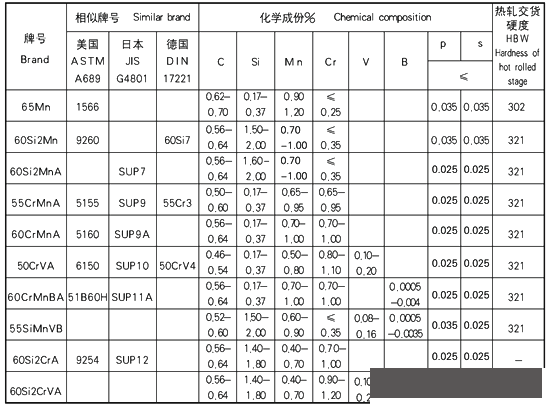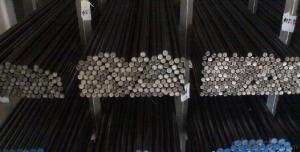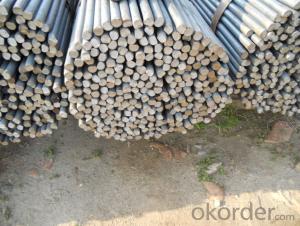Spring Steel 65Mn
- Loading Port:
- China Main Port
- Payment Terms:
- TT OR LC
- Min Order Qty:
- -
- Supply Capability:
- -
OKorder Service Pledge
Quality Product, Order Online Tracking, Timely Delivery
OKorder Financial Service
Credit Rating, Credit Services, Credit Purchasing
You Might Also Like

- Q:Are steel round bars suitable for machining operations?
- Steel round bars are an ideal choice when it comes to machining. The high strength and durability of steel make it a top-notch material for numerous machining processes. It's easy to shape, cut, drill, and turn steel round bars to create precise components and parts. When it comes to achieving the desired shape, size, and finish, milling, drilling, and turning can efficiently be performed on steel round bars. The dimensional stability and mechanical properties of steel round bars are exceptional, resulting in accurate and consistent machining outcomes. Whether it's the automotive, aerospace, construction, or manufacturing industry, steel round bars are a dependable option for machining operations.
- Q:How do I calculate the length of a steel round bar based on weight?
- To calculate the length of a steel round bar based on its weight, you need to know the density of steel and the weight of the bar. First, determine the density of steel, which is typically around 7850 kilograms per cubic meter. This value may vary depending on the type and grade of steel being used. Next, convert the weight of the steel round bar to kilograms if it is given in a different unit. For example, if the weight is given in pounds, you can multiply it by 0.4536 to convert it to kilograms. Once you have the weight in kilograms, you can use the formula: Length = Weight / (Density * π * (Diameter/2)^2) In this formula, the diameter should be in meters, so if it is given in a different unit, convert it accordingly. The symbol "π" represents the mathematical constant pi, which is approximately equal to 3.14159. By plugging in the values into the formula, you can calculate the length of the steel round bar. Remember to use consistent units throughout the calculation to obtain accurate results. It's important to note that this calculation assumes the round bar has a uniform diameter along its length. If the bar has varying diameters or irregularities, the calculation may provide an approximation rather than an exact length.
- Q:What are the different types of steel round bar surface finishes for improved cleanliness?
- There are several types of steel round bar surface finishes that can be used to improve cleanliness. 1. Bright Surface Finish: This is achieved by polishing the steel round bar, resulting in a smooth and reflective surface. Bright surface finishes are commonly used in applications where cleanliness and appearance are important, such as in the manufacturing of kitchen appliances or decorative items. 2. Satin Finish: This finish is achieved by brushing the steel round bar with fine abrasive pads, resulting in a smooth and matte surface. Satin finishes are often used in applications where a clean and modern aesthetic is desired, such as in architectural designs or furniture manufacturing. 3. Pickled Finish: This finish involves immersing the steel round bar in an acid solution, which removes any impurities or oxides from the surface. Pickled finishes are commonly used in applications where the steel round bar will be further processed, such as in the production of pipes or tubes. 4. Passivated Finish: This finish involves treating the steel round bar with a chemical solution, which forms a protective oxide layer on the surface. Passivated finishes are used to enhance the corrosion resistance of the steel round bar, making it suitable for applications in harsh or corrosive environments. 5. Shot Blasted Finish: This finish involves propelling small metal or ceramic particles at high velocity onto the surface of the steel round bar. Shot blasting removes any scale, rust, or surface contaminants, resulting in a clean and textured surface. Shot blasted finishes are commonly used in applications where a good bond between the steel round bar and another material, such as paint or coating, is required. Overall, the choice of steel round bar surface finish depends on the specific application and the desired level of cleanliness. Each finish offers unique properties and benefits, allowing for improved cleanliness and performance in various industries.
- Q:What is the difference between a forged and a peeled steel round bar?
- Both forged steel round bars and peeled steel round bars are utilized in various industries for different purposes. However, there exist notable distinctions between the two concerning their manufacturing procedures and physical attributes. To produce a forged steel round bar, a solid steel billet is heated to a high temperature and then shaped into the desired form by applying pressure. This process involves the use of machinery, such as hammers or presses, to shape the steel and create the round bar. The forging process enhances the strength and durability of the steel, making it suitable for applications that demand high strength and resistance to wear and tear. In contrast, a peeled steel round bar is manufactured using a different process called peeling or turning. During this procedure, a solid steel bar is rotated against a cutting tool, which eliminates the outer layer of the bar, resulting in a smooth and precise surface finish. Peeling eliminates any surface defects or imperfections present in the original bar, thereby enhancing its dimensional accuracy and surface quality. Regarding physical characteristics, forged steel round bars typically possess a rougher surface texture due to the nature of the forging process. This rough texture can provide improved grip or adhesion in certain applications. Additionally, forged bars often exhibit a denser and more uniform internal grain structure, contributing to their superior mechanical properties. On the other hand, peeled steel round bars exhibit a smooth and shiny surface finish as a consequence of the peeling process. This smooth surface makes peeled bars suitable for applications that prioritize aesthetic appeal or require a low coefficient of friction. However, the peeling process may result in a minor reduction in the overall diameter of the bar. In conclusion, the primary distinction between a forged and a peeled steel round bar lies in their manufacturing processes and resulting physical attributes. Forged bars are created through the application of pressure, resulting in a rougher surface texture and superior mechanical properties. Peeled bars, on the other hand, are produced by removing the outer layer of a steel bar, resulting in a smooth surface finish and improved dimensional accuracy. Ultimately, the choice between these two types of bars depends on the specific requirements of the application at hand.
- Q:What are the different types of steel round bar surface treatments for improved wear resistance?
- To enhance wear resistance, one can apply various surface treatments to different types of steel round bars. These treatments aim to improve the steel's hardness, toughness, and overall durability, making it more resistant to wear and corrosion. The most common surface treatments for steel round bars include: 1. Nitriding: By subjecting the steel to a nitrogen-rich environment at high temperatures, a hard nitride layer forms on the surface, enhancing wear resistance and hardness. 2. Carburizing: This process involves introducing carbon into the steel's surface, creating a high-carbon layer that increases hardness and wear resistance, making it suitable for applications requiring strength and durability. 3. Induction hardening: By selectively heating the steel's surface using an induction coil and rapidly quenching it, the resulting hardened layer provides excellent wear resistance while maintaining core toughness. 4. Shot peening: This treatment entails bombarding the steel surface with small metal or ceramic particles at high velocity, inducing compressive stresses that improve fatigue life and wear resistance. 5. Thermal spraying: Using a flame or plasma torch, a coating material is melted and sprayed onto the steel surface, creating a protective layer with enhanced wear resistance and corrosion protection. 6. PVD/CVD coatings: These involve depositing a thin layer of material onto the steel surface through Physical Vapor Deposition (PVD) or Chemical Vapor Deposition (CVD). These coatings offer excellent wear resistance, low friction, and improved corrosion protection. 7. Hard chrome plating: By electroplating a layer of chromium onto the steel surface, this process provides high hardness, wear resistance, and corrosion protection. It's crucial to consider specific application requirements and the desired type of wear resistance when choosing a surface treatment. Each treatment has its own advantages and limitations, and factors such as cost, environmental impact, and performance characteristics should be taken into account when selecting the most suitable treatment for a given steel round bar.
- Q:What is the tensile strength of steel round bars?
- The tensile strength of steel round bars can vary depending on the specific grade and composition of the steel. However, on average, steel round bars typically have a tensile strength ranging from 400 to 700 megapascals (MPa).
- Q:What is the maximum length available for steel round bars?
- The maximum length available for steel round bars can vary depending on the supplier and the specific requirements, but typically it can range from 12 to 24 feet.
- Q:Can steel round bars be coated for improved aesthetics?
- Yes, steel round bars can be coated for improved aesthetics. Coating steel round bars can enhance their appearance by providing a more polished and visually appealing surface. There are various coating options available, such as powder coating, electroplating, or painting, which can be applied to steel round bars to achieve different aesthetic effects. These coatings not only enhance the appearance of the bars but also provide additional benefits such as corrosion resistance and durability. Therefore, coating steel round bars is a common practice to improve their aesthetics in various applications including architectural, decorative, and industrial purposes.
- Q:How are steel round bars used in the manufacturing of heat exchangers?
- Steel round bars are commonly used in the manufacturing of heat exchangers due to their unique properties that make them suitable for this application. Heat exchangers are devices that transfer heat between two or more fluids, and steel round bars play a crucial role in their construction. One major use of steel round bars in heat exchangers is for the fabrication of the heat exchanger tubes. These tubes are responsible for carrying the fluids that need to be heated or cooled. Steel round bars are often used as the base material for these tubes due to their high strength and excellent heat transfer properties. The round shape of the bars allows for easy fabrication of the tubes, ensuring a tight and secure fit. Additionally, steel round bars are used to construct the headers and tube sheets of heat exchangers. The headers are the component that allows the fluid to enter and exit the heat exchanger, while the tube sheets hold the tubes in place. These components require high strength and durability to withstand the pressure and temperature differentials that occur during heat exchange. Steel round bars provide the necessary strength and stability to ensure the proper functioning of the heat exchanger. Furthermore, steel round bars are also used in the manufacturing of the support structures or frames of heat exchangers. These structures provide stability and support to the heat exchanger components and ensure proper alignment and positioning. Steel round bars offer excellent structural integrity and can withstand heavy loads, making them ideal for this purpose. In conclusion, steel round bars are an integral component in the manufacturing of heat exchangers. Their high strength, excellent heat transfer properties, and durability make them suitable for fabricating the tubes, headers, tube sheets, and support structures of heat exchangers. By utilizing steel round bars, manufacturers can ensure the efficiency, effectiveness, and longevity of heat exchangers in various industries, such as power generation, chemical processing, and HVAC systems.
- Q:How many positive and negative tolerances are allowed for round steel GB?
- Round steel is a solid strip of steel whose cross section is round. The specifications are expressed in millimeters of diameter, such as "50", which means a round bar of 50 millimeters in diameter. Round bar is divided into three parts: hot rolling, forging and cold drawing. Standard Specification for hot rolled round steel is 5.5-250 mm. Among them, 5.5-25 mm small round bars are mostly supplied by straight strips. They are used as reinforcing bars, bolts and various mechanical parts. They are more than 25 millimeters of round steel. They are mainly used in the manufacture of mechanical parts or seamless steel tube billets
1. Manufacturer Overview |
|
|---|---|
| Location | |
| Year Established | |
| Annual Output Value | |
| Main Markets | |
| Company Certifications | |
2. Manufacturer Certificates |
|
|---|---|
| a) Certification Name | |
| Range | |
| Reference | |
| Validity Period | |
3. Manufacturer Capability |
|
|---|---|
| a)Trade Capacity | |
| Nearest Port | |
| Export Percentage | |
| No.of Employees in Trade Department | |
| Language Spoken: | |
| b)Factory Information | |
| Factory Size: | |
| No. of Production Lines | |
| Contract Manufacturing | |
| Product Price Range | |
Send your message to us
Spring Steel 65Mn
- Loading Port:
- China Main Port
- Payment Terms:
- TT OR LC
- Min Order Qty:
- -
- Supply Capability:
- -
OKorder Service Pledge
Quality Product, Order Online Tracking, Timely Delivery
OKorder Financial Service
Credit Rating, Credit Services, Credit Purchasing
Similar products
New products
Hot products
Hot Searches
Related keywords































